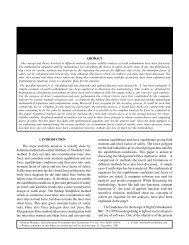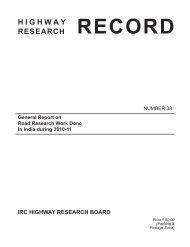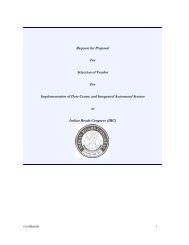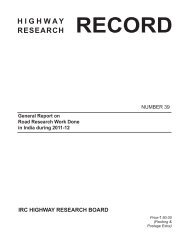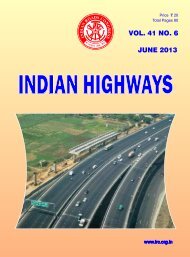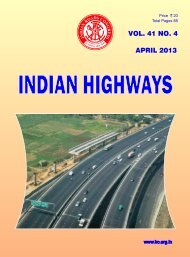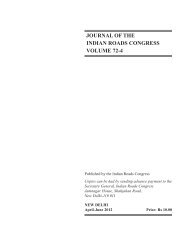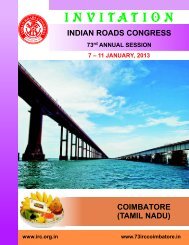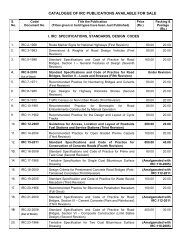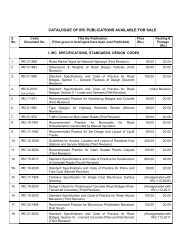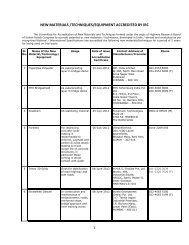Design and Construction of Pre-Tensioned Sutlej Bridge in Punjab
Design and Construction of Pre-Tensioned Sutlej Bridge in Punjab
Design and Construction of Pre-Tensioned Sutlej Bridge in Punjab
Create successful ePaper yourself
Turn your PDF publications into a flip-book with our unique Google optimized e-Paper software.
156<br />
be still successfully adopted as expansion/contraction tak<strong>in</strong>g<br />
place <strong>in</strong> pier caps <strong>and</strong> diaphragms connect<strong>in</strong>g the superstructure<br />
are same. Nevertheless, to avoid the transverse restra<strong>in</strong>t likely<br />
to be caused by thermal effects <strong>and</strong> w<strong>in</strong>d force, a typical semi<br />
classical bear<strong>in</strong>g arrangement as shown <strong>in</strong> the layout was<br />
adopted <strong>in</strong> <strong>Sutlej</strong> <strong>Bridge</strong>. As could be seen from the layout,<br />
there were two types <strong>of</strong> bear<strong>in</strong>gs <strong>in</strong> span <strong>and</strong> these two types<br />
<strong>of</strong> bear<strong>in</strong>gs might have different plate sizes <strong>and</strong> bolt<strong>in</strong>g<br />
locations, depend<strong>in</strong>g upon the forces, rotations <strong>and</strong> movements.<br />
In the precast construction like <strong>Sutlej</strong> <strong>Bridge</strong>, the grooves have<br />
to be left <strong>in</strong> the beams at the bolt<strong>in</strong>g locations <strong>and</strong> as such the<br />
manufacture <strong>of</strong> the bear<strong>in</strong>gs have to be approved prior to the<br />
precast<strong>in</strong>g <strong>of</strong> beams. Normally, the approval <strong>of</strong> bear<strong>in</strong>g<br />
manufacture is a very high lead-time item, which was well<br />
synchronised <strong>in</strong> this project. At each pier location for a span,<br />
two central bear<strong>in</strong>gs were fixed which were guided<br />
longitud<strong>in</strong>ally on the other side, where as two extreme girders<br />
on either side were transversely guided while on other side left<br />
free. This semi classical layout helped <strong>in</strong> reduc<strong>in</strong>g the types <strong>of</strong><br />
bear<strong>in</strong>gs to suit the precast construction.<br />
HEGGADE, MEHTA & PRAKASH ON<br />
Fig. 15. Bear<strong>in</strong>g configuration for <strong>Sutlej</strong> bridge<br />
10. LOAD TESTING OF SUPERSTRUCTURE<br />
In l<strong>in</strong>e with the contract agreement, one <strong>of</strong> the spans was<br />
to be validated by load test<strong>in</strong>g to the designed IRC load<strong>in</strong>g,<br />
<strong>in</strong>clud<strong>in</strong>g impact factor. As shown <strong>in</strong> the Fig. 16 the IRC load<strong>in</strong>gs<br />
were simulated for the maximum moments <strong>in</strong> the midspan<br />
<strong>in</strong>clud<strong>in</strong>g cycle track load<strong>in</strong>gs. All the pedestals were<br />
progressively <strong>and</strong> simultaneously loaded by progressive<br />
<strong>in</strong>crements <strong>of</strong> 25 per cent <strong>of</strong> the test load <strong>and</strong> the deflections<br />
were recorded at the midspan <strong>of</strong> all girders <strong>and</strong> <strong>and</strong> ¼th<br />
span <strong>of</strong> the third girder from left side. The maximum load was<br />
susta<strong>in</strong>ed for 24 hours; dur<strong>in</strong>g the period deflection read<strong>in</strong>gs<br />
were taken at one-hour <strong>in</strong>terval for the susta<strong>in</strong>ed load<strong>in</strong>g. Then<br />
the unload<strong>in</strong>g was simultaneously carried out <strong>in</strong> 25 per cent<br />
decrements with the read<strong>in</strong>gs taken dur<strong>in</strong>g each decrement.<br />
The deflection read<strong>in</strong>gs <strong>of</strong> unloaded structure cont<strong>in</strong>ued at<br />
one-hour <strong>in</strong>terval for further 48 hours.<br />
For each stage <strong>of</strong> load<strong>in</strong>g <strong>and</strong> unload<strong>in</strong>g, the observations<br />
were made about the likely appearance <strong>of</strong> cracks, the l<strong>in</strong>earity<br />
<strong>of</strong> the load deflection curves or any other abnormalities <strong>in</strong> the



